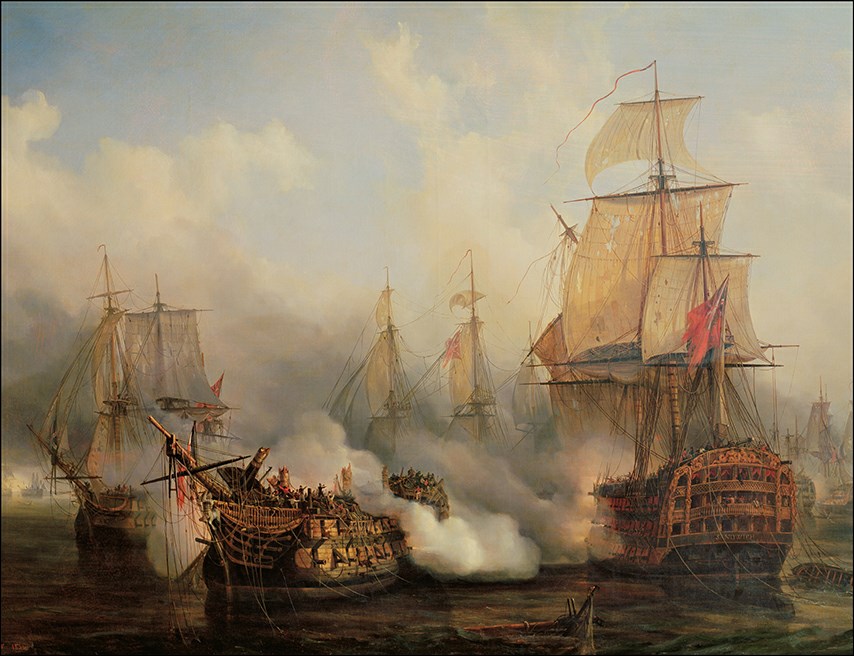
This painting by Auguste Mayer (1805–90) was long thought to show the
dismasted Redoutable but has been shown in fact to represent Bucentaure. The
British ship’s stern bears the name ‘Sandwich’ but HMS Sandwich was not at
Trafalgar.
Bucentaure’s name commemorated the French capture of Venice in May
1797: it was taken from the name of the Doge’s state barge, Bucintoro.
A new, handsome, well-proportioned 80-gun ship of the line,
it was the flagship of Admiral Villeneuve, commander-in-chief of the Combined
Fleet at the Battle of Trafalgar.
Bucentaure was the first of a class of 80-gun ships for the
Imperial French Navy. Sixteen were launched between 1803 and 1815, with a
further five up to 1824. The designer was Jacques-Noel Sané. Sané was an
advocate of uniformity in ship design, and beginning with Tonnant in 1789, was
responsible for a series of excellent ships. Armed with 84 guns, they were
classified as second-rates, but outgunned the typical British 74-gun ship and
were easier to handle than the massive 100-gun first-rates.
Longer than their British counterparts, more solidly
constructed and heavier, they were well-rigged and can fairly be claimed to be
the best ships of the time. Some commentators consider there to be a single
class from Tonnant to the final example, Vesuvio, not launched until 1824 and
sold to the Kingdom of the Two Sicilies.
The great problem for the French captains was not the
quality of their ships but that of their crews. The British Navy had worked
harder to train its officers and crews, helped in this respect by having far
more ships at sea, and for longer periods. The British crews were healthier,
with the shipboard scourge of scurvy largely prevented. The French captains
considered their crews to be a rabble. There is a phrase attributed to Nelson:
‘The best navy in the world would be made of French ships and English crews.’
But English crews also contained their full share of pressed men, freed prisoners
and army deserters.
Launch and service
Laid down at Toulon in November 1802, Bucentaure was
launched on 13 July 1803 and commissioned in January 1804. From first service
it was a flagship, at first of Vice Admiral Latouche-Tréville, who died on
board, to be succeeded by Vice Admiral Pierre de Villeneuve from 6 November
1804. In September 1805, the Combined Fleet was at Cadiz, when an order from
Napoleon instructed Villeneuve to embark troops and set sail for an invasion of
Naples. Cadiz was already closely watched by the British, and there was little
chance of leaving it without a battle. But Villeneuve learned that he was to be
replaced by Admiral Rosily, and despite having decided in September that the
Combined Fleet was not capable of action, he resolved to take his ships to sea
and vindicate his post in the eyes of Emperor Napoleon.
They left Cadiz on 21 October. On paper, Villeneuve had a
superior force, with 33 ships of the line (18 of them French) and seven
frigates, and with 2856 cannon at his disposal, while Nelson had 2314, on 27
ships of the line and six frigates. But the British admiral had seven
three-deckers while Villeneuve had only four.
Into battle
Bucentaure was commanded by Captain Jean-Jacques Magendie,
and in the line it took a central place. As the British, in their two
divisions, advanced, Villeneuve’s last signal was similar to Nelson’s: ‘Every
ship which is not in action is not at its post, and must take station to bring
itself as speedily as possible under fire.’ Victory fired a broadside that
ripped into the transom of Bucentaure at a range of only 9m (30ft), sweeping
the decks with shattering effect. In a few minutes Victory, Bucentaure,
L’Indomptable and HMS Temeraire were all abreast of or inboard each other,
rolling together, spars crashing, gunshots blasting off. At 13:40, shots from
HMS Conqueror brought down the main and mizzen masts.
‘A mass of wreckage’
At 13:45, now drifting helplessly in the midst of the
battle, with the bowsprit and all three masts fallen, and half the crew killed
or wounded, Bucentaure was described as ‘a mass of wreckage’ by the Captain.
Villeneuve tried to have his barge launched, to transfer his flag to a ship
still able to fight, but the boat was crushed beneath fallen spars. With no
alternative but to surrender Bucentaure struck its colours to Conqueror.
Villeneuve and Magendie were taken prisoner. A British prize crew was put on
board, with the surviving French crew held on board as prisoners, and the ship
was attached by a towline to Conqueror, but the line parted. The Frenchmen
managed to break out and retake the ship, but in the storm which arose on the
23rd, it was unmanageable. The ship struck a reef off Cadiz Bay, and foundered,
with a handful of survivors.
Specification
Dimensions Length
59.3m (194ft 6in), Beam 15.3m (50ft 3in), Draught 7.8m (25ft 6in)
Displacement 1455
tonnes (1604 tons)
Rig 3 masts, full
ship rig
Armament 30
36-pounders, 32 24-pounders, 18 12-pounder cannon; 6 36-pounder howitzers
Complement 866
sailors and marines